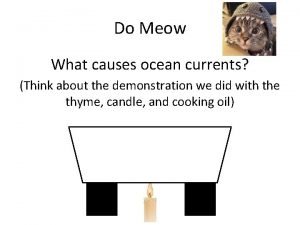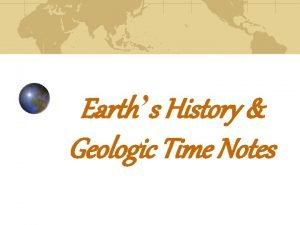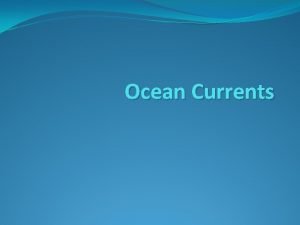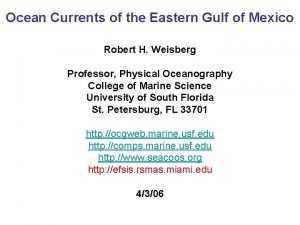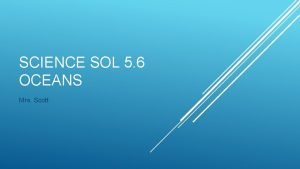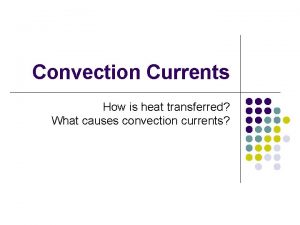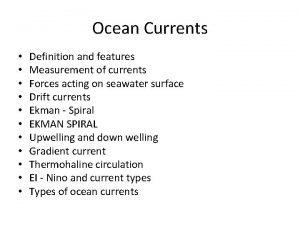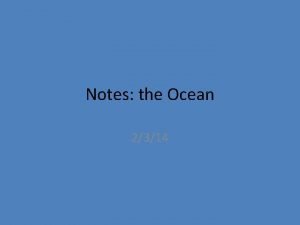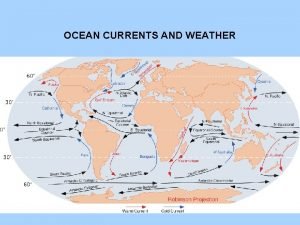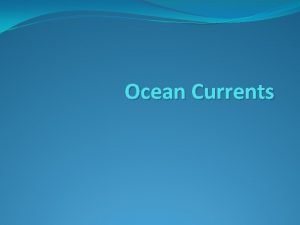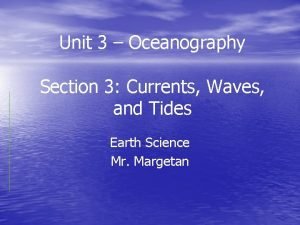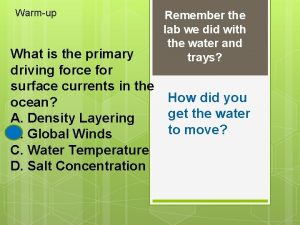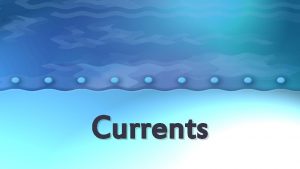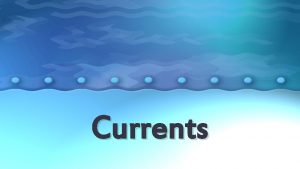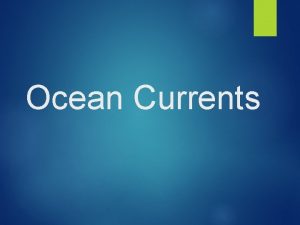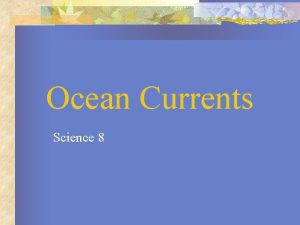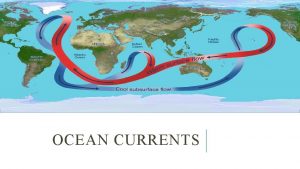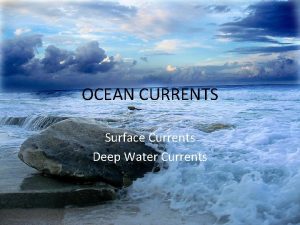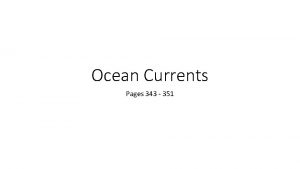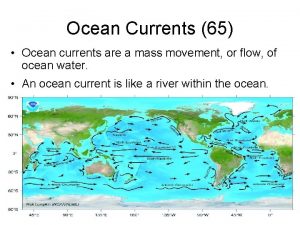11 2 Ocean Currents Ocean Currents Large amount













- Slides: 13

11. 2 Ocean Currents

Ocean Currents *Large amount of ocean water that moves, almost like a river in a particular and unchanging direction *More than 20 major currents *Move: dissolved minerals, solar energy, O 2, CO 2, as well as animals and plankton (microscopic plants and animals)

Two types: *Surface – up to 200 m deep *Deep water – more than 200 m deep *Surface currents - affected by wind, Earth’s spin, shape of continents *Deep currents - affected by temperature and salinity of the water *Waves and tides also move the ocean Surface and Deep Water Currents

The Effect of Wind *Air masses move from one area to another because of temp. differences (Fig. 11) *Energy is transferred to the water molecules, causing the water to move *Wind direction and speed directly related to surface currents What Makes Surface Currents Move?

The Effect of Spin *Earth spins from west to east *As winds and currents move they get redirected by this effect *= Coriolis effect = clockwise in North and counter-clockwise in South What Makes Surface Currents Move?

The Effect of Continent Shape *Continents act as natural barriers that affect current movement What Makes Surface Currents Move?

Water Temperature *Temperature affects density colder = more dense *Cold water sinks and moves along the bottom = density current *Three layers of ocean water: *Surface – warmest, keeps mixing, constant temp *Thermocline – temp. drops rapidly, also occur in lakes *Deep water – 2 degrees above freezing What Makes Deep Currents Move?

Water Salinity *High salinity means the water is more dense *To increase salinity – evaporation and freezing *To decrease salinity – fresh water from rivers and ice melting *Saltiest, coldest, densest water is found at the poles *It sinks and only surfaces after 500 -2000 years *Upwelling is the rising of the water from the deep and it brings nutrients to the surface = food for plankton *Upwelling occurs along the coast lines of N and S America What Makes Deep Currents Move?

*Waves are produced from surface winds *Size of wave depends on: *Speed of wind *Time the wind is over the water *Size of area wind passes over *Swells = large waves that form in the open ocean *When swells reach the shallow water they become breakers *Tsunami –created by an under water earthquake Ocean Waves and Their Effect of Shaping the Land

*Waves erode the coastline – how quickly depends on: * Force of the waves * Type of rock * Sand carried in the water *Waves behave depending on the shape of the coastline *Headlands = sections of coastline that extend into the ocean and are composed of harder rock *Receive most force of wave can create sea stacks *Bays = indented areas in the coastline Waves Erode the Land

Tides *Is the daily cycle of rising and falling ocean *Caused by the gravitational attraction between the Earth and the Moon *Gravitational effects depend on the distance between two bodies so because the moon and the Earth are close they attract strongly *Moon pulls on the water to give a high tide on one side of the earth and the low tide would be on the other side How do Tides Work?

*There are two high tides and two low tides on earth each day *Tidal range = difference between the high and low tide height *Shape of coast line affects how high the tide gets *Sun can also add to the affect and twice a month the create a lower low and a higher high = spring tides *Less extreme tides = neap tides How do Tides Work?

*Textbook Questions P. 427 Ques. *Workbook pages for 11. 2 *Quiz next class # 1 - 8, 10, 11 What are you to do ?
 Compared with surface currents deep currents are
Compared with surface currents deep currents are What are ocean currents
What are ocean currents Ocean currents project
Ocean currents project Coriolis effect vocabulary
Coriolis effect vocabulary Ocean currents gulf of mexico
Ocean currents gulf of mexico Midnight zone
Midnight zone What are the factors affecting the climate
What are the factors affecting the climate What causes convection
What causes convection What are ocean currents
What are ocean currents What are ocean currents
What are ocean currents Www.gulfstreamshutdown.com
Www.gulfstreamshutdown.com Coriolis force effect on ocean currents
Coriolis force effect on ocean currents Ocean currents
Ocean currents What is the primary driving force behind surface currents?
What is the primary driving force behind surface currents?

